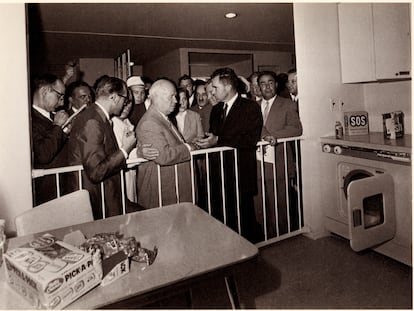Samantha Smith: the schoolgirl who became “America’s Youngest Peace Ambassador”
Samantha Smith, at just 10 years old, wrote a letter to Soviet leader Yuri Andropov, seeking to comprehend the tensions between the United States and the Soviet Union. Her courageous act catapulted her into the role of a “champion of peace”

In November 1982, when Yuri Andropov assumed leadership of the Soviet Union after Leonid Brezhnev, most children paid little attention to Soviet politics. However, Samantha Smith, born and raised in the United States was keenly aware of the Western media’s negative portrayal of Andropov, fueled by concerns over his past actions as chairman of the KGB. The media suggested that the Western world was on the verge of facing a new threat, causing increased nuclear anxiety during the Cold War.
A Time Magazine report featuring Andropov on the cover caught Samantha’s attention. Troubled by the fear surrounding him, she asked her mother a thought-provoking question: “If people are so afraid of him, why doesn’t someone write a letter asking whether he wants to have a war or not?” Encouraged by her mother’s response, Samantha took it upon herself to write that letter.
Samantha’s father worked as an educator at the University of Maine at Augusta, while her mother served as a social worker with the Maine Department of Human Services. Prior to her letter to Andropov, Samantha had expressed her admiration for the British monarch by writing a letter to Queen Elizabeth II.
The letter
In November 1982, the 10-year-old Samantha penned a short letter addressed to Yuri Andropov. She congratulated him on his new role and expressed her concerns about the possibility of a nuclear war. Samantha inquired whether Andropov intended to vote for war or if he had plans to prevent it. While acknowledging that he did not have to answer that question, Samantha emphasized the importance of sharing and caring for the world instead of fighting over it. The letter made its way to the Russian government and was subsequently published in the state-run newspaper Pravda. However, Samantha did not receive a direct response from Andropov, leading her to write to the Soviet ambassador to the U.S., Anatoly Dobrynin, inquiring about Andropov’s reply.
Nearly half a year later, on April 26, 1983, Samantha received a response from the Soviet leader. Andropov assured her that the Soviet Union was working diligently to prevent a nuclear war. He acknowledged her anxiety and shared his commitment to peace, referencing the United States and the Soviet Union’s collaboration during World War II against Nazi Germany. Andropov conveyed his desire for peaceful coexistence, trade, and cooperation among nations, specifically mentioning the United States. He also proposed discontinuing the production of nuclear weapons and expressed his wish for peace on Earth. In his letter, he invited Samantha and her parents to visit the Soviet Union and witness the country’s dedication to peace and friendship among peoples.
The exchange between Samantha and Andropov garnered significant media attention. She appeared on the Johnny Carson show, and major American networks reported the news.
The trip
On July 7, 1983, Samantha, accompanied by her parents, flew to Moscow and spent two weeks as Andropov’s guest. She explored Moscow and Leningrad and chose to stay with Soviet children at Artek, a children’s center in the Crimean Peninsula, instead of accepting special accommodations prepared for her. During a press conference, Samantha proclaimed that Russians were no different from Americans. However, critics speculated that the media frenzy surrounding Samantha was an American-style public relations tactic and accused her of being a tool for Soviet propaganda.
Due to Andropov’s deteriorating health, he was unable to meet Samantha during her visit, although they did speak on the phone. Following her return to the U.S. on July 22, 1983, Samantha’s popularity continued to rise. In December 1983, she traveled to Japan, where she met with Prime Minister Yasuhiro Nakasone and participated in the Children’s International Symposium in Kobe. During her speech, Samantha proposed an annual exchange of granddaughters between Soviet and American leaders, suggesting that such personal connections could deter conflicts. She later co-authored a book, “Journey to the Soviet Union,” about her experience with her father.
Subsequently, Samantha hosted a children’s special for The Disney Channel, where she interviewed candidates for the 1984 Democratic Party presidential primaries. She ventured into a television career, making guest appearances on shows like Charles in Charge and starring in the series Lime Street.
Unfortunately, Samantha’s life was cut short in a plane accident at the age of 15, along with her father. The investigation found no evidence of foul play. During her funeral, attended by several politicians, a personal message of condolence from Mikhail Gorbachev, then-General Secretary of the Communist Party of the Soviet Union, was read by Vladimir Kugalin of the Soviet Embassy in Washington, D.C. Gorbachev expressed how Samantha’s pursuit of peace resonated with millions of Soviet young men and women.
In 1986, a monument in Samantha’s honor was erected in Moscow at the Artek Young Pioneer camp. The Soviet Union also issued a commemorative stamp featuring her likeness. Additionally, the first Monday in June was officially designated as Samantha Smith Day in Maine, as per state law, and a bronze statue of her was placed near the Maine State Museum in Augusta.
To mark the 30th anniversary of the plane crash in 2015, the Maine State Museum presented a new exhibit displaying various artifacts associated with Samantha. The exhibit featured photographs depicting her time at the Artek camp, traditional Russian clothing gifted to her, and a copy of Soviet Life magazine prominently featuring her on the cover.
Samantha’s role as an ambassador inspired other exchanges of child goodwill ambassadors, such as Katya Lycheva, an 11-year-old Russian girl who traveled to the United States and also published a book about her experience.
Sign up for our weekly newsletter to get more English-language news coverage from EL PAÍS USA Edition
Tu suscripción se está usando en otro dispositivo
¿Quieres añadir otro usuario a tu suscripción?
Si continúas leyendo en este dispositivo, no se podrá leer en el otro.
FlechaTu suscripción se está usando en otro dispositivo y solo puedes acceder a EL PAÍS desde un dispositivo a la vez.
Si quieres compartir tu cuenta, cambia tu suscripción a la modalidad Premium, así podrás añadir otro usuario. Cada uno accederá con su propia cuenta de email, lo que os permitirá personalizar vuestra experiencia en EL PAÍS.
¿Tienes una suscripción de empresa? Accede aquí para contratar más cuentas.
En el caso de no saber quién está usando tu cuenta, te recomendamos cambiar tu contraseña aquí.
Si decides continuar compartiendo tu cuenta, este mensaje se mostrará en tu dispositivo y en el de la otra persona que está usando tu cuenta de forma indefinida, afectando a tu experiencia de lectura. Puedes consultar aquí los términos y condiciones de la suscripción digital.
More information
Archived In
Últimas noticias
Most viewed
- Oona Chaplin: ‘I told James Cameron that I was living in a treehouse and starting a permaculture project with a friend’
- Sinaloa Cartel war is taking its toll on Los Chapitos
- Reinhard Genzel, Nobel laureate in physics: ‘One-minute videos will never give you the truth’
- Why the price of coffee has skyrocketed: from Brazilian plantations to specialty coffee houses
- Silver prices are going crazy: This is what’s fueling the rally











































